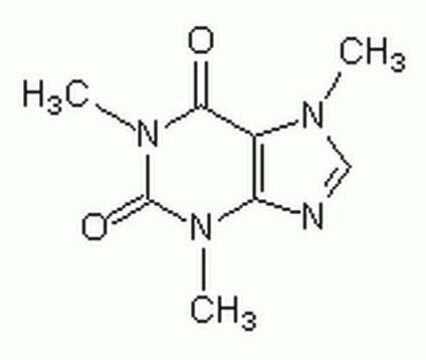Kluczowe dokumenty
W222402
Caffeine
anhydrous, 99%, FCC, FG
Synonim(y):
1,3,7-Trimethylxanthine
About This Item
Polecane produkty
pochodzenie biologiczne
synthetic
Poziom jakości
klasa czystości
FG
Halal
Kosher
anhydrous
zgodność regionalna
EU Regulation 1334/2008 & 178/2002
FCC
FDA 21 CFR 182.1180
Próba
99%
Formularz
powder
mp
234-236.5 °C (lit.)
rozpuszczalność
H2O: soluble 18.7 g/L at 16 °C
Zastosowanie
flavors and fragrances
Dokumentacja
see Safety & Documentation for available documents
alergen pokarmowy
no known allergens
Organoleptyczne
odorless
ciąg SMILES
CN1C(=O)N(C)c2ncn(C)c2C1=O
InChI
1S/C8H10N4O2/c1-10-4-9-6-5(10)7(13)12(3)8(14)11(6)2/h4H,1-3H3
Klucz InChI
RYYVLZVUVIJVGH-UHFFFAOYSA-N
informacje o genach
human ... ADORA1(134) , ADORA2B(136) , ADORA3(140) , PDE4B(5142)
mouse ... Adora2b(11541)
rat ... Adora1(29290) , Adora2a(25369)
Szukasz podobnych produktów? Odwiedź Przewodnik dotyczący porównywania produktów
Powiązane kategorie
Opis ogólny
Zastosowanie
- Anti-hair loss effect of a shampoo containing caffeine and adenosine.: Discusses the efficacy of a shampoo formulated with caffeine and adenosine in reducing hair loss, underscoring caffeine′s role in enhancing hair follicle activity and promoting hair health (Chen et al., 2024).
Hasło ostrzegawcze
Warning
Zwroty wskazujące rodzaj zagrożenia
Zwroty wskazujące środki ostrożności
Klasyfikacja zagrożeń
Acute Tox. 4 Oral
Kod klasy składowania
11 - Combustible Solids
Klasa zagrożenia wodnego (WGK)
WGK 1
Środki ochrony indywidualnej
dust mask type N95 (US), Eyeshields, Faceshields, Gloves
Wybierz jedną z najnowszych wersji:
Masz już ten produkt?
Dokumenty związane z niedawno zakupionymi produktami zostały zamieszczone w Bibliotece dokumentów.
Klienci oglądali również te produkty
Nasz zespół naukowców ma doświadczenie we wszystkich obszarach badań, w tym w naukach przyrodniczych, materiałoznawstwie, syntezie chemicznej, chromatografii, analityce i wielu innych dziedzinach.
Skontaktuj się z zespołem ds. pomocy technicznej




